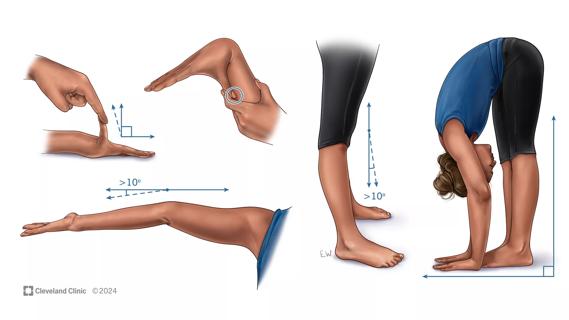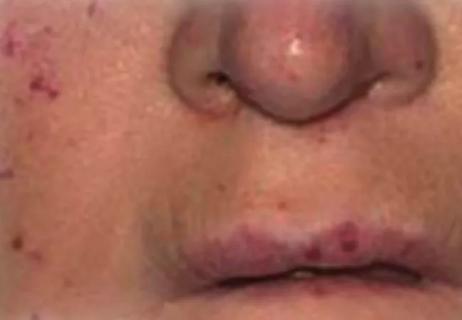Oral medication reduces epistaxis and improves quality of life for patients with rare vascular disorder

An NIH-supported, randomized, placebo-control clinical trial found pomalidomide to be safe and effective for treating the rare vascular disorder hereditary hemorrhagic telangiectasia (HHT), for which there currently exists no FDA-approved medications. Patients receiving pomalidomide experienced notable reductions in nosebleed frequency and severity, less reliance on blood and iron transfusions, and improved quality of life. The study results were published in the New England Journal of Medicine.
Advertisement
Cleveland Clinic is a non-profit academic medical center. Advertising on our site helps support our mission. We do not endorse non-Cleveland Clinic products or services. Policy
Remarkably, this research grew out of an interaction with one patient. A patient with life-threatening bleeding from HHT and von Willebrand disease was referred to Keith McCrae, MD, professor of molecular medicine at the Cleveland Clinic. He consulted the literature and found several case reports suggesting that thalidomide may be effective for treating HHT. He prescribed it to his patient off label, and within three to four weeks, the bleeding had virtually stopped.
After seeing significant responses in the handful of other patients to whom he prescribed the medication, Dr. McCrae reached out to the drug manufacturer, who agreed to fund a pilot study of nine patients with its newly-developed thalidomide analogue, pomalidomide. This study showed a clear signal of efficacy and had dramatic improvements in several patients.
Based on this data, Dr. McCrae secured an NIH R34 Clinical Trial Planning Grant to fund the creation of a team to develop a study. From there, he secured an NIH grant for the full clinical trial. “A colleague of mine once told me ‘Don’t ignore the N of one,” says Dr. McCrae. “We tend to think of N of thousands, but when you see a remarkable response like this in one patient, we can’t write that off. As physicians and physician scientists, we need to keep our eyes open for these opportunities.”
HHT (also known as Osler-Weber-Rendu Syndrome) is caused by tangled blood vessels, which result in frequent nosebleeds and gastrointestinal bleeds. More severe cases can be life threatening, involving the lungs, brain and liver, and can result in cerebral hemorrhage, decreased blood oxygen and heart failure, often on top of major GI bleeding. Even for those with HHT that’s considered mild, the disease has a detrimental effect on patients’ lives.
Advertisement

“People sometimes don’t think of nosebleeds as any big deal, but they are extremely uncomfortable and completely unpredictable,” says Dr. McCrae, the study’s senior author. “As you can imagine, having an unexpected nosebleed when you’re going about your daily life can be devastating. Patients have a poor quality of life, with roughly 50% reporting significant depression.”
Mild cases may be treated with nasal hydration, tranexamic acid or endoscopic ablation, but for systemic manifestations, there are few effective options. There has been some success in treating isolated lesions in the lungs or brain with interventional radiology approaches or resection. Bevacizumab has shown some efficacy in non-randomized single-arm studies for addressing severe nosebleeds and some GI bleeds, though a randomized study of bevacizumab was underpowered and did not achieve its primary endpoint.
Pomalidomide is an FDA approved medication for relapsed/refractory multiple myeloma. The pilot study of nine patients showed a clear signal for efficacy, including significant improvements for several of the study participants. Based on this data, Dr. McCrae then secured an NIH R34 Clinical Trial Planning Grant to build a team to develop the study. From there, he received NIH approval for a full clinical trial. The patient advocacy organization Cure HHT worked closely with Dr. McCrae and his team to identify and recruit patients who could potentially benefit from the trial.
The funding agency for this study was the National Heart, Lung and Blood Institute (NHLBI), which also oversaw study enrollment rates and assembled an independent data safety monitoring board tasked with regularly monitoring study safety. Medication was provided without cost by the drug manufacturer.
Advertisement
This was a placebo-controlled, double-blinded randomized trial. The researchers used the Epistaxis Severity Score to gauge the severity of each enrolled patient’s nosebleeds, and recorded the amount of iron or number of units of red blood cells transfused during the study. The investigators also used an HHT-specific quality-of-life tool developed during the study planning to assess each patient’s quality of life.
Between November 2019 and June 2023, 144 adults with HHT participated in the trial at 11 U.S. medical centers, including Cleveland Clinic. All patients enrolled had moderate-to-severe nosebleeds at baseline. Patients were randomized to either receive pomalidomide or a placebo. In all, 95 participants received 4 mg of pomalidomide each day, with some doses being reduced to 2-3 mg for those with side effects, which were most commonly rash, constipation or low white blood count.
Prior to the study, the mean Epistaxis Severity Score at baseline was 5.0±1.5 (4.9 pomalidomide, 5.2 placebo). At 24 weeks, the score in patients treated with pomalidomide decreased by a mean [95% CI] of -1.84 [-2.24, -1.44]. and in the placebo group, the score decreased by -0.89 [-1.39, -0.39] (mean difference -0.95 [-1.58, -0.32], p = 0.003). 43 months into the four-year trial, an analysis found subjects in the pomalidomide arm were faring significantly better than those on placebo, and exceeding a predefined threshold for efficacy. At that time, the NHLBI requested that the study halt further randomization and enrollment early, due to the unequivocal demonstration of efficacy.
Advertisement
Cleveland Clinic is home to an HHT Center of Excellence, co-directed by Dr. McCrae and Dr. Joseph Parambil. The center treats more than 300 patients with HHT, providing coordinated care across pulmonology, hematology, neurology, neurosurgery, ENT and related disciplines. Quite a few patients who were on the trial have continued on the medication, with the support of the drug manufacturer. A handful who no longer take the medication also continued to experience fewer nosebleeds four to six months after stopping treatment.
Advertisement
Advertisement

Rare genetic disorder prevents bone mineralization

Experienced clinicians can bridge traditional care gap

A recently published case series highlights the broad range of laryngeal findings that can present among individuals with EDS

The disorder can greatly impact patients’ quality of life, but sclerotherapy and a multidisciplinary approach to care can be life-changing

Cleveland Clinic pioneers a new paradigm in cardiovascular care delivery

National database study reveals insights into survival outcomes

Site visits offer firsthand lessons in clinical and operational excellence in cardiovascular care

Evolving thinking on when and how to treat brain aneurysms and AVMs